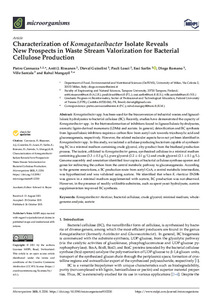Characterization of komagataeibacter isolate reveals new prospects in waste stream valorization for bacterial cellulose production
Cannazza, Pietro; Rissanen, Antti J.; Guizelini, Dieval; Losoi, Pauli; Sarlin, Essi; Romano, Diego; Santala, Ville; Mangayil, Rahul (2021-10)
Cannazza, Pietro
Rissanen, Antti J.
Guizelini, Dieval
Losoi, Pauli
Sarlin, Essi
Romano, Diego
Santala, Ville
Mangayil, Rahul
10 / 2021
2230
Julkaisun pysyvä osoite on
https://urn.fi/URN:NBN:fi:tuni-202111108321
https://urn.fi/URN:NBN:fi:tuni-202111108321
Kuvaus
Peer reviewed
Tiivistelmä
Komagataeibacter spp. has been used for the bioconversion of industrial wastes and lignocel-lulosic hydrolysates to bacterial cellulose (BC). Recently, studies have demonstrated the capacity of Komagataeibacter spp. in the biotransformation of inhibitors found in lignocellulosic hydrolysates, aromatic lignin-derived monomers (LDMs) and acetate. In general, detoxification and BC synthesis from lignocellulosic inhibitors requires a carbon flow from acetyl-coA towards tricarboxylic acid and gluconeogenesis, respectively. However, the related molecular aspects have not yet been identified in Komagataeibacter spp. In this study, we isolated a cellulose-producing bacterium capable of synthesiz-ing BC in a minimal medium containing crude glycerol, a by-product from the biodiesel production process. The isolate, affiliated to Komagataeibacter genus, synthesized cellulose in a minimal medium containing glucose (3.3 ± 0.3 g/L), pure glycerol (2.2 ± 0.1 g/L) and crude glycerol (2.1 ± 0.1 g/L). Genome assembly and annotation identified four copies of bacterial cellulose synthase operon and genes for redirecting the carbon from the central metabolic pathway to gluconeogenesis. According to the genome annotations, a BC production route from acetyl-CoA, a central metabolic intermediate, was hypothesized and was validated using acetate. We identified that when K. rhaeticus ENS9b was grown in a minimal medium supplemented with acetate, BC production was not observed. However, in the presence of readily utilizable substrates, such as spent yeast hydrolysate, acetate supplementation improved BC synthesis.
Kokoelmat
- TUNICRIS-julkaisut [16983]
